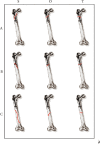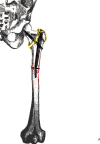Fractures around Trochanteric Nails: The "Vergilius Classification System"
- PMID: 33520318
- PMCID: PMC7817309
- DOI: 10.1155/2021/7532583
Fractures around Trochanteric Nails: The "Vergilius Classification System"
Abstract
Introduction: The fractures that occurred around trochanteric nails (perinail fractures, PNFs) are becoming a huge challenge for the orthopaedic surgeon. Although presenting some specific critical issues (i.e., patients' outcomes and treatment strategies), these fractures are commonly described within peri-implant ones and their treatment was based on periprosthetic fracture recommendations. The knowledge gap about PNFs leads us to convene a research group with the aim to propose a specific classification system to guide the orthopaedic surgeon in the management of these fractures.
Materials and methods: A steering committee, identified by two Italian associations of orthopaedic surgeons, conducted a comprehensive literature review on PNFs to identify the unmet needs about this topic. Subsequently, a panel of experts was involved in a consensus meeting proposing a specific classification system and formulated treatment statements for PNFs. Results and Discussion. The research group considered four PNF main characteristics for the classification proposal: (1) fracture localization, (2) fracture morphology, (3) fracture fragmentation, and (3) healing status of the previous fracture. An alphanumeric code was included to identify each characteristic, allowing to describe up to 54 categories of PNFs, using a 3- to 4-digit code. The proposal of the consensus-based classification reporting the most relevant aspects for PNF treatment might be a useful tool to guide the orthopaedic surgeon in the appropriate management of these fractures.
Copyright © 2021 Giuseppe Toro et al.
Conflict of interest statement
The authors declare that they have no conflicts of interest.
Figures
References
-
- Tarantino U., Iolascon G., Cianferotti L., et al. Clinical guidelines for the prevention and treatment of osteoporosis: summary statements and recommendations from the Italian Society for Orthopaedics and Traumatology. Journal of Orthopaedics and Traumatology. 2017;18(S1):3–36. doi: 10.1007/s10195-017-0474-7. - DOI - PMC - PubMed
-
- Niu E., Yang A., Harris A. H. S., Bishop J. Which fixation device is preferred for surgical treatment of intertrochanteric hip fractures in the United States? A survey of orthopaedic surgeons. Clinical Orthopaedics and Related Research. 2015;473(11):3647–3655. doi: 10.1007/s11999-015-4469-5. - DOI - PMC - PubMed
LinkOut - more resources
Full Text Sources
Other Literature Sources
Miscellaneous






